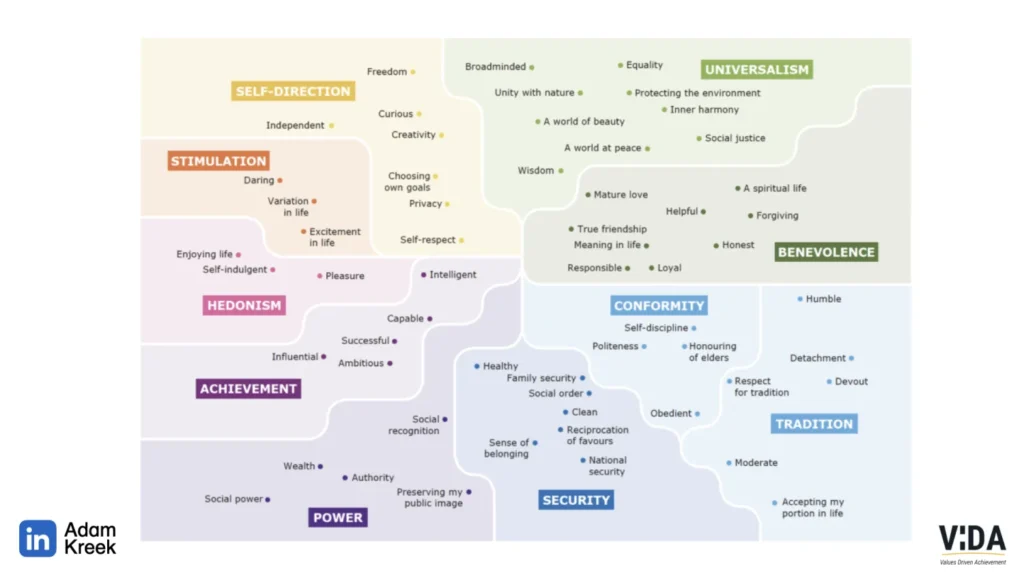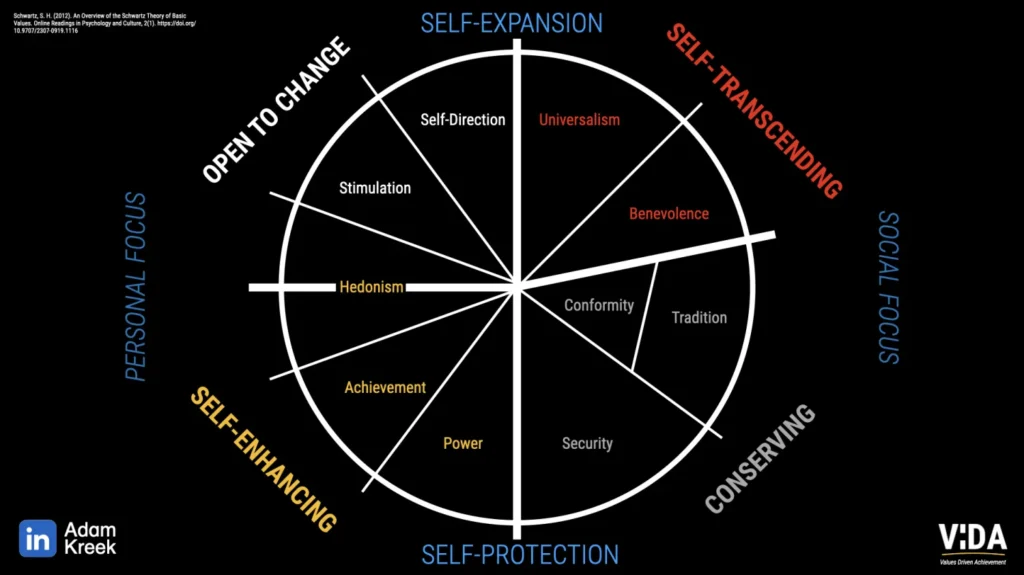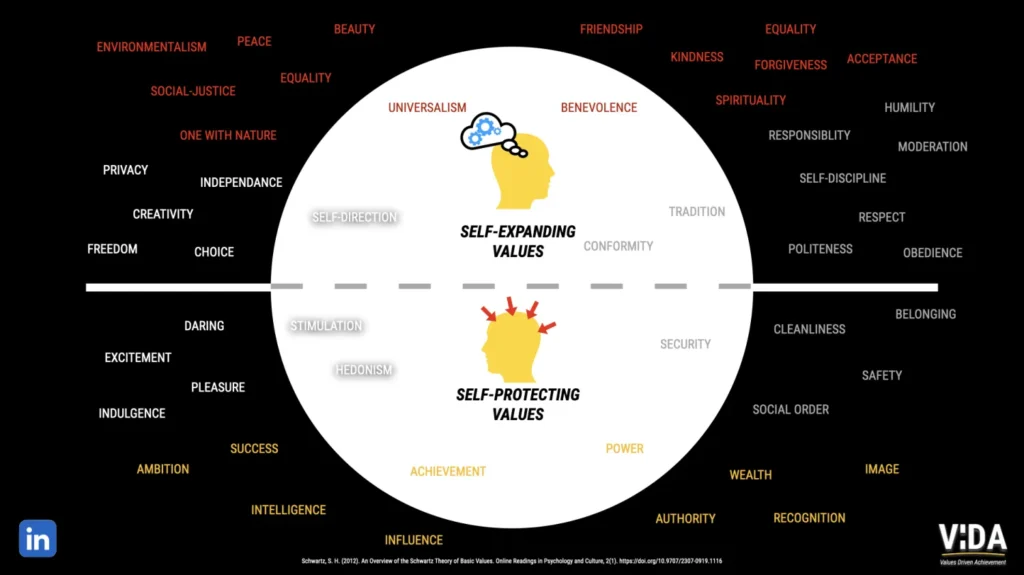
"The dynamic relationships among values reveal conflicts between the pursuit of different values that can result in tension and complexity."
Shalom Schwartz
Social Psychologist
- Date
Conflicting Values and their Shadows
posted in Values

Adam Kreek
Exploring Schwartz's Theory of Values and the Shadows Within
Understanding our values can be a complex journey. Have you ever considered why certain decisions feel right while others leave you conflicted?
Enter Schwartz's Theory of Values, a comprehensive model that shines a light on these very conflicts. Developed by Shalom H. Schwartz, this theory identifies ten basic personal values that are recognized universally across cultures. But it's not just about identifying values; it's about understanding the tensions and conflicts between them. Let’s dive into how this model, combined with the idea of shadow values, can help us achieve a more integrated and authentic self.
A Brief History of Schwartz and His Model
Shalom H. Schwartz, a social psychologist, developed the Schwartz Theory of Basic Values in the early 1990s. Schwartz's work was groundbreaking because it provided a systematic method to study and compare values across different cultures. His work helps us understand our personal values in the context of our culture in a way similarl to the World Values Survey. He identified ten basic values, each with its own motivational goal, that people around the world recognize. These values are:
- Self-Direction: Independent thought and action
- Stimulation: Excitement, novelty, and challenge
- Hedonism: Pleasure and sensuous gratification
- Achievement: Personal success through demonstrating competence
- Power: Social status and control over resources
- Security: Safety and stability of society, relationships, and self
- Conformity: Restraint of actions likely to upset or harm others and violate social norms
- Tradition: Respect, commitment, and acceptance of the customs and ideas that one's culture or religion provide
- Benevolence: Preserving and enhancing the welfare of those with whom one is in frequent personal contact
- Universalism: Understanding, appreciation, tolerance, and protection for the welfare of all people and nature

The Conflict of Values
Schwartz’s model doesn’t just stop at identifying these values. It also highlights the inherent conflicts between them. For instance, the pursuit of Self-Direction and Stimulation often clashes with Security and Conformity. Achievement and Power can conflict with Benevolence and Universalism. These tensions reflect our internal struggles and the compromises we must make in our daily lives.
One of the most overlooked truths in values-based leadership is this:
Even the most virtuous values are in conflict with other virtuous values.
The Schwartz Theory of Basic Human Values maps values on a circular continuum. Adjacent values support each other. Opposing values create tension. These tensions matter because they shape the hidden dynamics in our decision-making, relationships, and strategy.

Below are some of the key conflicts built into this model:
1. Self-Transcendence vs. Self-Enhancement
- Self-Transcendence: Universalism, Benevolence
- Self-Enhancement: Achievement, Power, Personal Success
- The Conflict: You can’t lead with altruism and social justice while simultaneously optimizing for personal gain, dominance, and recognition. At some point, you will have to choose: Am I serving others or serving myself?
2. Openness to Change vs. Conservation
- Openness to Change: Creativity, Curiosity, Autonomy, Risk-taking
- Conservation: Security, Conformity, Tradition, Stability
- The Conflict: You can’t simultaneously maintain strict safety protocols and encourage disruptive innovation. Trying to do both usually creates gridlock.
3. Hedonism vs. Conformity
- Hedonism: Pleasure, Enjoyment of Life
- Conformity: Obedience, Humility, Deference to Norms
- The Conflict: Pursuing freedom and indulgence will eventually clash with systems that demand obedience and self-restraint.
4. Universalism vs. Achievement
- Universalism: Social justice, Environmental sustainability, Equality
- Achievement: Goal-setting, Personal recognition, High performance
- The Conflict: When you push hard for performance and outcomes, you often undercut inclusive processes or longer-term sustainability. And when you champion equity and fairness, you may have to accept that some forms of measurable success come slower.
5. Security vs. Stimulation
- Security: Order, Safety, Predictability
- Stimulation: Novelty, Challenge, Change
- The Conflict: A highly secure, stable environment resists the very unpredictability that stimulation and growth require.
Integrating Conflicting Values
Understanding these value tensions helps you do two things:
- Recognize your own inner contradictions — especially when you feel blocked or stuck.
- Diagnose friction in relationships and organizations — often, people aren’t resisting you. They’re defending their values.
This is why I keep saying: values are decision fuel, not decoration. They don’t just shape what you say you believe—they determine what you actually do under pressure.
Shadow Values: The Unseen Influencers
Let’s bring in a concept from Jungian psychology: shadow values.
These are the unacknowledged aspects of our value system — the hidden motivations that operate below the waterline. They’re the impulses we often deny, repress, or project onto others.
For example, a leader who prizes Achievement might consciously value excellence and progress. But if that drive is rooted in unacknowledged insecurity — a need to prove worth or protect status — they’ll eventually clash with colleagues who hold Benevolence as a core value. Without awareness, their efforts to “give back” will ring hollow. Others will sense the incongruence between motive and message.
That’s the essence of shadow values: when we ignore them, they lead us.
Our shadow values create inner conflict. They surface as burnout, hypocrisy, or disconnection between what we say we value and how we actually behave.
Integrate Your Hidden Drivers
The work of integration begins when we’re willing to look directly at them. When we bring these shadow values into the light, we gain access to their energy and insight. Achievement can then be guided by contribution. Power can evolve into stewardship. Security can coexist with courage.
Values don’t exist in isolation. They’re dynamic, alive, and often in tension. That’s what makes them so powerful — and so volatile.
When we understand that our values naturally compete, we can stop moralizing them as “good” or “bad.” Instead, we start leading with awareness — balancing our light and shadow, our ambition and empathy, our need for control and our hunger for change.
Alignment doesn’t mean perfection. It means honesty.
And when you lead with that kind of honesty, your values stop being words on a wall and start becoming fuel for authentic achievement.

Integrating Shadow Values
How do we bring these shadow values into the light? Here are some steps:
- Self-Reflection: Take time to reflect on your actions and motivations. What values of self-protection are driving your decisions? Are there any recurring patterns or conflicts? What values conflicts do you notice?
- Identify Triggers: Notice situations where you feel particularly defensive, angry, or upset. These reactions can indicate shadow values at play.
- Embrace Vulnerability: Acknowledge that these shadow values are a part of you. Embracing them without judgment can lead to greater self-acceptance.
- Seek Balance: Understand that values exist in a dynamic balance. Recognizing and honouring both your light and shadow values can help you navigate conflicts more effectively.
Bringing It All Together
Understanding and integrating our values, including the shadow ones, is crucial for personal growth and authenticity. Schwartz’s Theory of Values provides a framework to identify and analyze these values, while the concept of shadow values helps us uncover and integrate the parts of ourselves that we might otherwise ignore.
As Schwartz once said, "Values guide the selection or evaluation of actions, policies, people, and events. Thus, value priorities influence all aspects of our lives." His quote underlines the pervasive influence of values in our daily decisions and interactions, showing that conflicts arise naturally as different values prioritize different actions and outcomes, making consistent decision-making a challenging task
Your values journey is not just about personal insight; it’s about aligning your values with your actions, both in your personal life and professional endeavours. As you explore these aspects of yourself, you’ll find that living in alignment with your true values leads to greater fulfillment and a more meaningful life.
If you’re interested in further exploring how values shape our lives and the conflicts they create, check out these related blogs:
By bringing your values into the light, both the cherished and the shadowed, you can create a life of greater authenticity and purpose. So, let’s embrace the full spectrum of our values and let them guide us to a more integrated and fulfilling life.
–––––
Adam Kreek and his team are on a mission to positively impact organizational cultures and leaders who make things happen.
He authored the bestselling business book, The Responsibility Ethic: 12 Strategies Exceptional People Use to Do the Work and Make Success Happen.
Want to increase your leadership achievement? Learn more about Kreek’s coaching here.
Want to book a keynote that leaves a lasting impact? Learn more about Kreek’s live event service here.